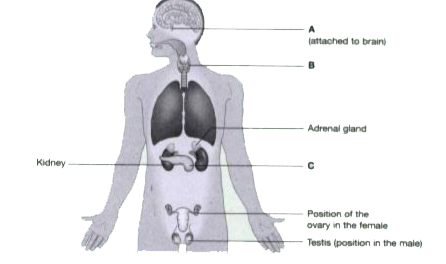Plant hormones play a role in regulating seed germination. The graph shows changes in hormone concentrations (left axis) and hypocotyl growth (right axis) over time for moong bean. Which hormone(s) most likely regulates hypocotyl (bean sprout) growth during moong bean germination?

Gibberellic acid
Auxin
Cytokinin alone
Both (a) and (b)
The correct Answer is:d
Step by step video, text & image solution for Plant hormones play a role in regulating seed germination. The graph shows changes in hormone concentrations (left axis) and hypocotyl growth (right axis) over time for moong bean. Which hormone(s) most likely regulates hypocotyl (bean sprout) growth during moong bean germination? by Biology experts to help you in doubts & scoring excellent marks in Class 11 exams.
Topper's Solved these Questions
Similar Questions
Hormones play a vital role in regulating the growth, development, behavioral development and reproduction . Our body produces about 30 hormones that remain active in our body. Kindly check the diagram and try to answer the questions below :

Name the gland which is present in the throat of both males and females and produces a hormone called thyroxine.View SolutionHormones play a vital role in regulating the growth, development, behavioral development and reproduction . Our body produces about 30 hormones that remain active in our body. Kindly check the diagram and try to answer the questions below :

Name the disease which is caused due to lack of iodine in the body.View Solution
Knowledge Check
- Question 1 - Select One
Read the given statements and identify the plant hormones X,Y and Z.
(i) Hormone Y induces flowering in mango and also promotes rapid internode/petiole elongation in deep water rice plants and hence helping leaves or upper part of shoot to remain above water.
(ii) Hormone X promotes root growth and root hair formation.
(iii) Hormone Z inhibits the seed germination, increases the tolerance of plant to various stresses, play important role in seed development, maturation and dormancy.AY−ABA,X−Auxin,Z−GABY−C2H4X−Auxin,Z−GACY−Auxin,X−C2H4,Z−GADY−C2H4,X−C2H4,Z−ABA - Question 2 - Select One
Read the given statements and identify the plant hormones X,Y and Z.
(i) Hormone Y induces flowering in mango and also promotes rapid internode/petiole elongation in deep water rice plants and hence helping leaves or upper part of shoot to remain above water.
(ii) Hormone X promotes root growth and root hair formation.
(iii) Hormone Z inhibits the seed germination, increases the tolerance of plant to various stresses, play important role in seed development, maturation and dormancy.AY = ABA, X = Auxin, Z = GABZ = GA, X= Auxin, Y = C2H4CY = Auxin, X = C2H4, Z= GAADY=C2H4:X=C2H4,Z=ABA - Question 3 - Select One
Read the following passage and answer the questions given afterit. The ocean will not look the same colour in the future. Essentially, climate change will make the blues of the ocean bluer and the greens greener. Scientists from MIT, Boston, figured this out by creating a global model that simulates the growth of a tiny creature that lives in the oceans and affects the colour we see. Their research was published in the journal Nature Communications. The ocean looks blue or green to us because of a combination of how sunlight interacts with water molecules and with whatever else lives in that water.
The molecules in water absorb all but the blue part of the spectrum of sunlight, and the water reflects that blue colour back. That.s the colour wesee.
The water looks greener when it has more phytoplankton, tiny, microscopic organisms that, like plants, can use chlorophyll to capture mostly the blue portions of the spectrum of sunlight. They then use photosynthesis to create the chemical energy they need to live. When there are more of these creatures in the water absorbing sunlight, they make the water look greener. Conversely, if there are fewer phytoplankton, the waterlooks bluer.
The creatures. growth is dependent on how much sunlight, carbon dioxide and nutrients are around. Climate change is altering the ocean currents, meaning there will be fewer nutrients for phytoplankton to feed on in some areas, so there will be a decline in their numberin those regions. Since the 1990s, satellites have taken regular measurements of how much chlorophyll is in the ocean. Those levels can change because of weather events or because of climate change. The study predicts that the blues will intensify, most likely in subtropical regions where phytoplankton will decrease. These are areas near the equator like Bermuda and the Bahamas that are already quite lowin phytoplankton.
Regions where there are a lot of nutrients, like in the Southern Ocean or parts of the North Atlantic, will see even faster-growing. phytoplankton because those waters are warming with climate change. Those waters will look greener.
Climate change will bring a colour change to half of the world.s oceans by the end of the 21st century, the study says. That.s bad on several levels: For one, phytoplankton remove about as much carbon dioxide from the air as plants and help regulate our climate, research shows. They are also key to other animals. survival. "Phytoplankton are at the base, and if the base changes, it endangers everything else along the food web, going far enough to the polar bears or tuna or just about anything that you want to eat or love to see in pictures," said Stephanie Dutkiewicz, a principal research scientist in MIT.
In which areas will the ocean look bluer?ASouthern oceanBAreas near polesCAreas near equatorDNorth Atlantic ocean
Read the given passage and answer question number 1 to 5 that follow :
Hormones are molecules that act as intercellular messengers . These are produced by endocrine glands in the body and are poured directly in the blood stream which transports them to the site of action .
In terms of chemical nature , some of these steriod ,e.g., estrogens and androgens, some other are amino acid derivatives such as epinephrine and norepinephrine.
Hormones have several function in the body. The help to maintain theh balance of biological activities in the body . The role of insulin in keeping the blood glucose level within the narrow limits is an example of this function . Insulin is relased in response to the rapid rise in blood glucose level . On the other hand hormore glucagon tends to increase the glucose level in the blood . The two hormones together regulate teh glucose level in the blood. Epinephrine and norepinephrine mediate respones to external stimuli.Growth hormones and sex hormones play role in the grwoth and development. Thyroxine produced in the thyroid gland is an iodinated derivative of amino acid tyrosine.
What kind of hormone is insulin ?View SolutionRead the given passage and answer question number 1 to 5 that follow :
Hormones are molecules that act as intercellular messengers . These are produced by endocrine glands in the body and are poured directly in the blood stream which transports them to the site of action .
In terms of chemical nature , some of these steriod ,e.g., estrogens and androgens, some other are amino acid derivatives such as epinephrine and norepinephrine.
Hormones have several function in the body. The help to maintain theh balance of biological activities in the body . The role of insulin in keeping the blood glucose level within the narrow limits is an example of this function . Insulin is relased in response to the rapid rise in blood glucose level . On the other hand hormore glucagon tends to increase the glucose level in the blood . The two hormones together regulate teh glucose level in the blood. Epinephrine and norepinephrine mediate respones to external stimuli.Growth hormones and sex hormones play role in the grwoth and development. Thyroxine produced in the thyroid gland is an iodinated derivative of amino acid tyrosine.
Define hormone is insulin ?View SolutionRead the given passage and answer question number 1 to 5 that follow :
Hormones are molecules that act as intercellular messengers . These are produced by endocrine glands in the body and are poured directly in the blood stream which transports them to the site of action .
In terms of chemical nature , some of these steriod ,e.g., estrogens and androgens, some other are amino acid derivatives such as epinephrine and norepinephrine.
Hormones have several function in the body. The help to maintain theh balance of biological activities in the body . The role of insulin in keeping the blood glucose level within the narrow limits is an example of this function . Insulin is relased in response to the rapid rise in blood glucose level . On the other hand hormore glucagon tends to increase the glucose level in the blood . The two hormones together regulate teh glucose level in the blood. Epinephrine and norepinephrine mediate respones to external stimuli.Growth hormones and sex hormones play role in the grwoth and development. Thyroxine produced in the thyroid gland is an iodinated derivative of amino acid tyrosine.
What is the role of epinephrine and norepinephrine ?View SolutionRead the given passage and answer question number 1 to 5 that follow :
Hormones are molecules that act as intercellular messengers . These are produced by endocrine glands in the body and are poured directly in the blood stream which transports them to the site of action .
In terms of chemical nature , some of these steriod ,e.g., estrogens and androgens, some other are amino acid derivatives such as epinephrine and norepinephrine.
Hormones have several function in the body. The help to maintain theh balance of biological activities in the body . The role of insulin in keeping the blood glucose level within the narrow limits is an example of this function . Insulin is relased in response to the rapid rise in blood glucose level . On the other hand hormore glucagon tends to increase the glucose level in the blood . The two hormones together regulate teh glucose level in the blood. Epinephrine and norepinephrine mediate respones to external stimuli.Growth hormones and sex hormones play role in the grwoth and development. Thyroxine produced in the thyroid gland is an iodinated derivative of amino acid tyrosine.
What are different functions of hormoes ?View SolutionRead the given passage and answer question number 1 to 5 that follow :
Hormones are molecules that act as intercellular messengers . These are produced by endocrine glands in the body and are poured directly in the blood stream which transports them to the site of action .
In terms of chemical nature , some of these steriod ,e.g., estrogens and androgens, some other are amino acid derivatives such as epinephrine and norepinephrine.
Hormones have several function in the body. The help to maintain theh balance of biological activities in the body . The role of insulin in keeping the blood glucose level within the narrow limits is an example of this function . Insulin is relased in response to the rapid rise in blood glucose level . On the other hand hormore glucagon tends to increase the glucose level in the blood . The two hormones together regulate teh glucose level in the blood. Epinephrine and norepinephrine mediate respones to external stimuli.Growth hormones and sex hormones play role in the grwoth and development. Thyroxine produced in the thyroid gland is an iodinated derivative of amino acid tyrosine.
What is thyroxine ?View Solution
